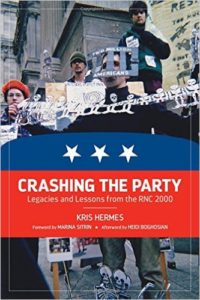Crashing the Party: Legacies and Lessons from the RNC 2000
Reviewed by J.E. McNeil
June 1, 2016
 By Kris Hermes. PM Press, 2015. 336 pages. $22.95/paperback.
By Kris Hermes. PM Press, 2015. 336 pages. $22.95/paperback.
Buy on QuakerBooks
The author, a legal worker (non-lawyer) member of the National Lawyers Guild, stated early on that he proposed “to write about the legal and political events as both a firsthand participant and an objective observer.” From what I knew from various accounts—the press, the National Lawyers Guild’s, and my nephew’s (he had been arrested during the events in the book)—few, if any, of the participants in the horrific events surrounding the 2000 Republican National Convention in Philadelphia, Pa., were “objective” about what happened.
But I was wrong. The book is a detailed, exacting retelling of the events before, during, and after—long after—the convention had left Philadelphia. It is a chilling story, well told. In it are many accounts of solidarity, betrayal, bravery, and brutality.
The basic story is about the groups who sought to protest many issues during and around the Republican gathering in Philadelphia in August 2000. Hermes notes that some of the actions had foreshadowing in the Seattle World Trade Organization protests. In those protests, the activists ably used various educational, street theater, and arrest-and-trial strategies as well as legal observers. And the government effectively used disinformation tactics, initially convincing the general public that the protests were largely led by violent, black-clad anarchists.
The alliances who sought to protest the convention spent more than a year planning and preparing—as did the police. The activists were spied upon, infiltrated, harassed, and eventually—in many cases before the events—arrested. In particular, the proposed peaceful street theater’s puppets, float, and banners were destroyed prior to the event, with everyone in the staging area arrested whether they were connected to it or not. The treatment of the activists by the police during the arrests and while in custody without bail hearings in jail was vicious. The criminal charges were outrageous violations of constitutional rights. People in authority lied and colluded. Eventually, 95 percent of those arrested were not convicted.
Many of the methods and strategies used by the activists will not be new to Friends, such as consensus decision making. Others will be things with which we are not in accord, such as “a pushback against the rigidity of ‘nonviolence.’” Hermes explains coherently the strategies of arrest solidarity, jail solidarity, and court solidarity as well. But he also includes mistakes and failures of the activists. He relates, for example, a story of activists robbed when they handed bail money to a young African American man whom they failed to vet as they normally would have. This event led to a discussion among the activists of the inherent racism in trusting people more because they are members of an oppressed class.
Hermes relates all of this in great detail, using transcripts, interviews, and media reports.
The book ends with his own analysis of the events and strategy and that of many of the other participants, by itself well worth reading. And clearly the events had several important results. One result, and foremost for me, was the understanding at a new depth by the predominantly young, white, affluent protesters of just how horrible and racist the prison and justice system is in our country. Reading and hearing about something is very different from experiencing and witnessing it. Another result was the strengthening of direct action trends among young activists of color. As Kazembe Balagun, a SLAM (Student Liberation Action Movement) member noted: “direct action, done correctly, can foster solidarity across racial and gender lines, and that’s something we definitely learned.”
But even as some were radicalized, others such as Ryan Harvey, political activist and organizer, realized:
We have a lot of work to do, and most of it is not going to get done in the streets. It’s going to get done on the doorsteps, the libraries, the churches, the labor halls, the schools, the military bases, the parks, the prisons, the abortion clinics, the neighborhood associations, the PTAs.
Even if you do not share all of the beliefs of the activists, Crashing the Party is an important read for those who would like to understand the various anti-globalization actions before and since. Even if some of the political analysis leaves you cringing, Crashing the Party provides useful insights for peace work in our meetings. Even if you do not choose to engage in direct action or even protest, Crashing the Party is a revealing take about the dysfunction of our legal system, prison systems, and society.
We have a lot of work to do.



Comments on Friendsjournal.org may be used in the Forum of the print magazine and may be edited for length and clarity.